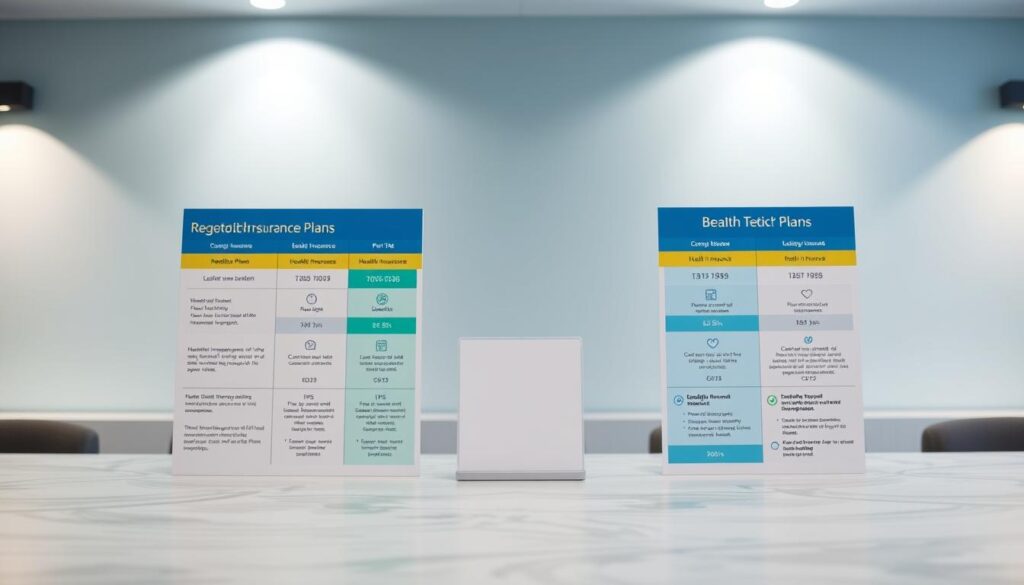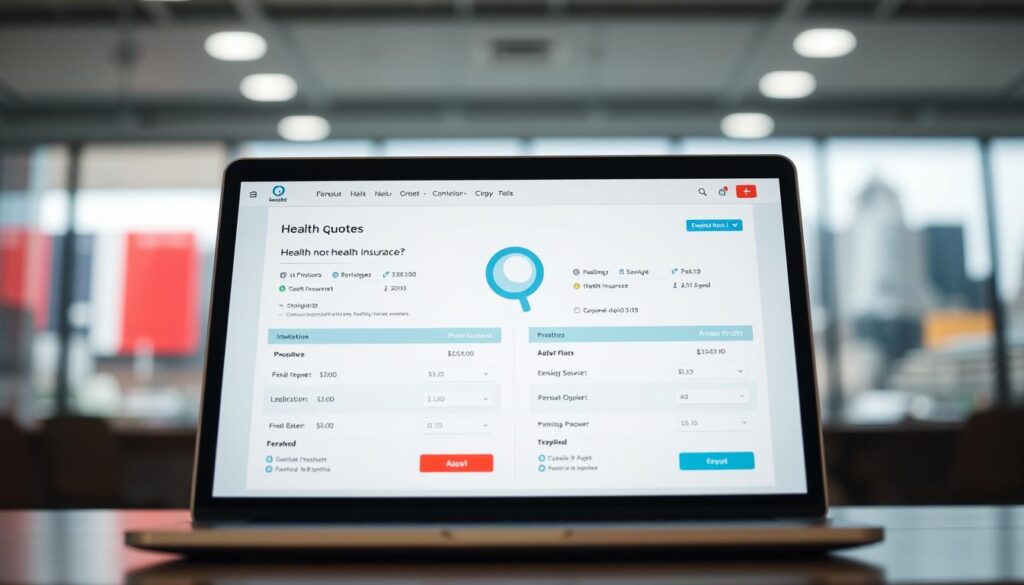Did you know the US health insurance market is expected to hit $1.6 trillion by 2025? With so many health insurance companies in the US, picking the right one can feel like a big task.
We’ll help you compare health insurance quotes and coverage from top names like UnitedHealthcare, Elevance Health, and Centene Corporation.
As we look at the top health insurance coverage options, we’ll talk about what matters most to you. We’ll also share key insights into the industry’s leaders.
Key Takeaways
- Overview of the top health insurance providers in the US
- Key factors to consider when comparing health insurance quotes
- Understanding the different health insurance coverage options
- Insights into the US health insurance market trends
- Tips for choosing the right health insurance company for your needs
Understanding Health Insurance Basics
Health insurance is more than just picking a plan. It’s about keeping your health and finances safe. With so many options, it’s key to understand the basics well.
Types of Health Insurance Plans
There are many health insurance plans, each with its own benefits. Here are some common ones:
- HMOs (Health Maintenance Organizations): You must get care from a certain network of doctors.
- PPOs (Preferred Provider Organizations): You can see any doctor, in-network or out-of-network, but costs vary.
- EPOs (Exclusive Provider Organizations): A mix of HMOs and PPOs, with a network of preferred doctors but no out-of-network care except in emergencies.
- POS (Point of Service) plans: You can choose to see a network doctor or an out-of-network doctor at a higher cost.
Key Insurance Terminology
Knowing key insurance terms helps you understand health insurance better. Here are some important ones:
| Term | Description |
|---|---|
| Deductible | The amount you pay before your insurance starts covering costs. |
| Copayment | A fixed cost you pay for a service, usually at the time of service. |
| Coinsurance | A percentage of costs you pay after meeting your deductible. |
The Importance of Proper Coverage
Having the right health insurance is key to your financial health. It lets you get the medical care you need without financial stress. It’s important to think about your health needs and choose a plan that fits them.
When picking a plan, think about your health, finances, and what you prefer. This way, you’ll be well-covered and ready for any medical costs.
Criteria for Comparing Health Insurance Plans
To make a smart choice, we need to look at health insurance plans carefully. We focus on key factors that affect the plan’s quality and cost.
Network Size and Provider Access
The size of the network and access to doctors are key. A bigger network means more choices for healthcare. It’s important that our doctors and hospitals are in the network.
Network Types:
- HMO (Health Maintenance Organization)
- PPO (Preferred Provider Organization)
- EPO (Exclusive Provider Organization)
Premium Costs and Deductibles
It’s crucial to understand the premium and deductible costs. Sometimes, lower premiums mean higher deductibles. We need to find a balance that fits our budget and health needs.
| Plan | Premium Cost | Deductible |
|---|---|---|
| Plan A | $300/month | $1,000 |
| Plan B | $250/month | $2,000 |
| Plan C | $350/month | $500 |
Customer Service Reputation
The reputation of the insurance company’s customer service is also important. We look for companies known for efficient claims processing and good customer support.
Key aspects to consider:
- Claims processing efficiency
- Customer support availability
- User reviews and ratings
Coverage Options and Flexibility
Lastly, we check the coverage options and flexibility. We want to know what’s covered, any limits, and if we can change our coverage later.
By looking at these criteria, we can compare health insurance plans. This helps us find a plan that fits our needs for coverage and affordability.
Top Health Insurance Companies in the United States
In the United States, leading health insurance providers stand out for their unique features. The health insurance market is very competitive. Several major companies offer plans for different needs.
UnitedHealthcare
UnitedHealthcare is the biggest health insurer in the U.S. It offers many health insurance plans. Its wide network and varied plan options make it a favorite among people. UnitedHealthcare has plans for individuals, families, and those on Medicare and Medicaid.
Blue Cross Blue Shield
Blue Cross Blue Shield (BCBS) is a big name in U.S. health insurance. It works with many regional affiliates, giving members access to care nationwide. This is great for those who travel or have family in different states.
Aetna
Aetna is known for its health management programs. Aetna focuses on preventive care and wellness. It offers plans for individuals, families, and groups, plus Medicare plans.
Cigna
Cigna is a global health insurance company with a big presence in the U.S. Cigna’s focus on global coverage is appealing to those with international connections. It has a variety of plans, including individual and family, and employer-sponsored options.
These top health insurance companies are known for their wide coverage, big networks, and good customer service. When picking a health insurance provider, look at these factors to find the right one for you.
Step1: Assess Your Healthcare Needs
Before you start looking at health insurance, think about your healthcare needs now and in the future. This will help you pick a plan that’s right for you and your family.
Evaluating Personal and Family Medical Requirements
First, look at your and your family’s medical history. Do you or your family have ongoing health issues? Conditions like diabetes, heart disease, or asthma can affect your healthcare needs a lot. Make a list of the medical services you use each year, like doctor visits and hospital stays.
Considering Prescription Medication Needs
If you or your family take prescription drugs often, think about how much they cost. Check if your insurance plans cover these drugs and what you’ll pay for them. “A health insurance plan that covers your prescription needs can save you hundreds, if not thousands, of dollars annually,” experts say.
Accounting for Specialist Care
Think about if you need to see specialists, like a cardiologist or orthopedic doctor. Some insurance plans limit access to specialists. Make sure your plan includes your preferred specialists or look for plans with out-of-network coverage if needed.
Budgeting for Healthcare Expenses
Healthcare costs are more than just monthly payments. You also need to think about deductibles, copays, and out-of-pocket maximums. Visit https://www.venteur.com/blog/apply-for-individual-health-insurance to learn about applying for individual health insurance and understanding different plan costs.
By carefully looking at these factors, you can choose a health insurance plan that meets your needs without costing too much.
Step2: How to Research Health Insurance Companies
Choosing a health insurance company is a big decision. You need to research well to pick a good one. We’ll show you how to do this research effectively.
Using Online Comparison Tools
Online tools are great for comparing health insurance plans. They let you see different plans side by side. You can look at costs, deductibles, and what’s covered.
There are many online tools out there. They give quotes, summaries, and reviews. These help you find the best plan for you.
Checking Company Ratings and Reviews
It’s important to check how health insurance companies are rated. Look for ratings from groups like the National Committee for Quality Assurance (NCQA) or the Better Business Bureau (BBB).
Customer reviews also give valuable insights. Check out reviews on different sites to understand a company’s reputation better.
Consulting with Insurance Brokers
Insurance brokers can be very helpful. They know a lot about health insurance plans. They can suggest plans that fit your needs.
When talking to a broker, ask about their experience and the companies they work with. Also, ask how they help find the best plan for you.
Exploring Employer-Sponsored Options
If you have a job, look at your employer’s health insurance. Many companies offer health insurance as a benefit.
When checking these options, think about the costs, what’s covered, and the doctors you can see. Compare these with individual plans to make sure you’re getting the best deal.
| Research Method | Description | Benefits |
|---|---|---|
| Online Comparison Tools | Websites that compare multiple health insurance plans | Easy comparison, time-saving, and informed decision-making |
| Company Ratings and Reviews | Ratings from independent organizations and customer feedback | Insights into company reputation, strengths, and weaknesses |
| Insurance Brokers | Experts who guide you through the health insurance market | Personalized recommendations, extensive knowledge, and navigation assistance |
| Employer-Sponsored Options | Group health insurance plans offered by employers | Potential cost savings, comprehensive coverage, and convenience |
Step3: Analyze Plan Details and Benefits
To make a smart choice, we must look closely at the details and benefits of different health insurance plans. This step is key to picking a plan that fits our health needs and budget.
Comparing Coverage Limitations
When we compare health insurance plans, it’s important to know what’s covered and what’s not. Coverage limitations can affect how much we pay out of pocket and our access to care.
For example, some plans might not cover specialist care or certain treatments. We should carefully check these limits to make sure the plan meets our health needs.
| Plan | Coverage Limitations | Out-of-Pocket Maximum |
|---|---|---|
| Plan A | No coverage for alternative therapies | $5,000 |
| Plan B | Limited coverage for specialist care | $6,000 |
| Plan C | No limitations on coverage | $7,000 |
Understanding Out-of-Pocket Maximums
The out-of-pocket maximum is the most we have to pay for healthcare in a year. After hitting this limit, the plan covers 100% of eligible costs. Knowing this helps avoid surprise costs.
For example, if a plan’s out-of-pocket maximum is $5,000, we won’t pay more than that for covered services in a year. This can be a big help, like for those with ongoing health issues or needing lots of medical care.

Evaluating Additional Benefits
Many health insurance plans come with additional benefits that can improve our coverage. These might include telehealth services, wellness programs, and preventive care. It’s important to look at these benefits to see the plan’s true value.
For instance, telehealth services make it easier to see doctors without going in person. Wellness programs help us stay healthy and prevent diseases. We should think about these benefits when we compare plans.
Assessing Telehealth Options
Telehealth options are becoming more important, offering flexibility and convenience in getting healthcare. When we look at health insurance plans, we should check the quality and availability of telehealth services.
This means understanding what services are covered, who the providers are, and any costs involved. Telehealth is great for those with tight schedules or living far from healthcare services.
Step4: Consider Special Circumstances and Options
Health insurance can be complex, and special situations can affect our choices. Different life events need unique approaches to picking the right health insurance.
Medicare and Medicaid Considerations
For those 65 and older, or with disabilities, Medicare is key. It’s important to know Medicare’s parts, like A for hospitals and B for doctors. Part D covers prescription drugs. Medicaid helps low-income families and varies by state.
For more help, check out Six Steps to Determining the Right Health Insurance.
Options for Self-Employed Individuals
Self-employed people have unique health insurance needs. They can’t rely on employer plans. The Health Insurance Marketplace offers plans for individuals and families.
Family Plans vs. Individual Coverage
Choosing between family and individual plans depends on your family size and health needs. Family plans are often cheaper for big families. Individual coverage might be better for those with specific health needs.
Handling Pre-existing Conditions
The Affordable Care Act (ACA) ensures no one is denied coverage due to health issues. It’s vital to check how insurance companies handle pre-existing conditions. Look for any extra costs or limitations.
By thinking about these special situations, you can choose the best health insurance providers wisely. It’s about finding the right balance of coverage, cost, and personal needs.
Step5: Request and Compare Health Insurance Quotes
Comparing health insurance quotes is key to finding the right plan for you and your family. We’ve already looked at our healthcare needs and researched providers. Now, it’s time to get quotes and make a choice.
How to Get Accurate Quotes
To get accurate quotes, have your personal and medical info ready. This includes your age, health status, and any pre-existing conditions. Insurance companies use this info to give you a quote that fits your situation.
Tips for getting accurate quotes:
- Be honest about your health history
- Provide detailed info about your dependents, if applicable
- Specify your preferred healthcare providers and facilities
Reading the Fine Print
After getting your quotes, read the fine print carefully. Know what’s covered, what’s not, and any limits or exclusions. Look closely at coverage details, deductibles, copays, and coinsurance.
Key areas to focus on:
- Coverage for essential health benefits
- Out-of-pocket maximums
- Network providers and specialists

Understanding Enrollment Periods
Health insurance enrollment periods change based on your situation. For most, the annual open enrollment period is the main chance to enroll or change plans. But, life events like getting married or having a child might open a special enrollment period.
Important enrollment periods to know:
- Annual open enrollment period (typically November 1 – December 15)
- Special enrollment periods triggered by life events
- Medicare and Medicaid enrollment periods
Making the Application Process Smooth
To make the application process smooth, gather all needed documents first. This includes ID, income proof, and any medical records. A complete and accurate application will help avoid delays or issues.
Tips for a smooth application:
- Double-check your application for errors
- Submit your application well before the deadline
- Keep a record of your application submission
Conclusion
Choosing the right health insurance plan is important. You need to think about network size, premium costs, and coverage options. Top companies like UnitedHealthcare, Blue Cross Blue Shield, Aetna, and Cigna have plans for different needs.
To make a good choice, look at your healthcare needs. Research the companies and compare plans. Don’t forget to consider special situations like Medicare and Medicaid, or options for self-employed people.
By comparing plans and understanding their benefits and limits, you can pick the best one for you. This way, you get quality healthcare while keeping costs down.


